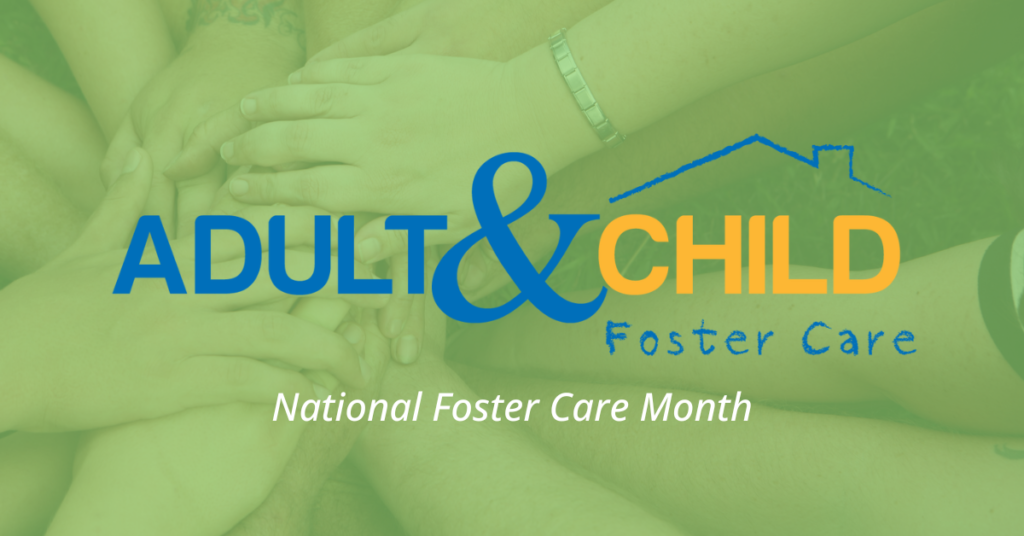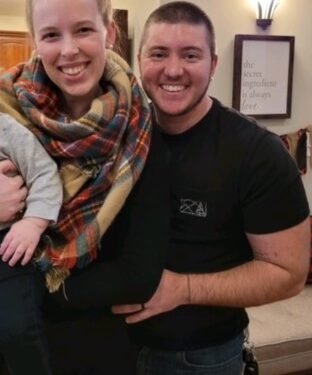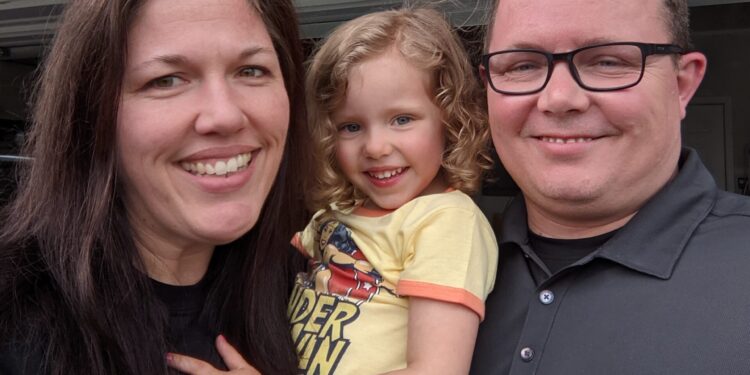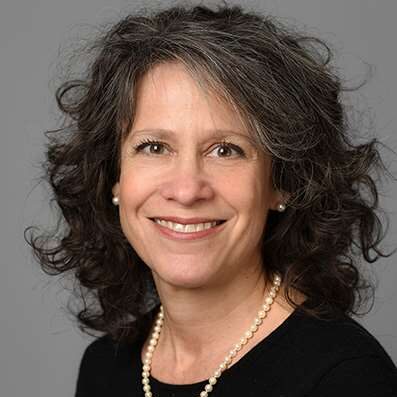National Foster Care Month: “Engaging Youth. Building Supports. Strengthening Opportunities.”

May is National Foster Care Month. This year’s National Foster Care Month theme, “Engaging Youth, Building Supports, Strengthening Opportunities” emphasizes the importance of a child welfare system that authentically engages and supports young people who are preparing to leave foster care. At Adult & Child Health— and nation-wide— we are urgently searching for foster parents willing to open their homes and act as mentors to older youth. Foster Parents as Youth Mentors Due to past trauma and system involvement, youth in foster care often struggle to trust adults. Foster parents have the ability to be stable and consistent people in youths’ lives. By showing unconditional care and support, setting boundaries, and allowing youth to have a voice in their own stories, they help youth to rebuild their trust in others. Many of A&C’s foster parents support youth from foster care well after they have “aged out” of the system. By providing long-lasting and permanent relationships with youth, these mentors help the youth cope with past trauma and learn how to heal. These relationships also provide a guide for what healthy relationships can look like for them in the future. Foster parents help youth with little to no family support access resources such as financial aid for college, resources for safe and stable housing, practice interviewing for jobs, and support and encouragement to make positive decisions that will help them achieve success in adulthood. Pursuing Permanency: Upstream Preventions In the context of child welfare, permanency means that a child has “a safe, stable and secure home and family, love, unconditional commitment, and lifelong support in the context of reunification, adoption, or legal guardianship.” The first step toward achieving permanency is ensuring that adults have the supports and services they need to care for the children in their lives. At Adult & Child Health, we know the value of the continuum of care that our staff are able to provide to our patients and clients. Our comprehensive, wide-ranging services touch the whole health journey, from prevention and outreach to treatment and management/enabling services. The ultimate goal of A&C’s services in regards to permanency would be to eliminate the need for a child to be removed from their home due to unsafe circumstances. The continuum of care is crucial in creating a safe, healthy, and care-free childhood for children in our communities. Service lines that don’t directly work with youth have the capability to positively impact adults, lifting them up and enabling them to care for the children in their lives in more effective and compassionate ways. Youth placed in A&C-licensed foster homes also have connections to the support our staff offer. Primary Prevention: Programs and services designed to promote the general welfare of children and families. Secondary Prevention: Services identified and provided to families who have identified risk factors for maltreatment. Tertiary Prevention: Services provided after the occurrence of abuse or neglect. These services are designed to prevent the recurrence of abuse. Most of Adult & Child Health’s services fall under primary prevention. It’s even described in our value statement: “We strive for equitable, caring communities, where every child, adult, and family have opportunities to live healthy, purposeful lives.” Our child welfare and wraparound teams play a large role in secondary prevention, with therapeutic foster care and behavioral health/therapy services stepping in to provide additional tertiary prevention. The ability to focus on upstream efforts to build stronger families is a major positive outcome of Adult & Child’s continuum of care. According to Prevent Child Abuse Indiana, “by focusing especially on primary prevention, we can help mitigate the necessity of the other two.” Fostering as a Community Support In cases where it is unsafe for a child to remain in their home of origin, a foster family steps in to provide appropriate care and a loving, temporary home. The foster family is connected to an array of resources to support themselves and the child, while the parent(s) of origin are also supported in taking steps toward reunification whenever possible. Permanency is vital for nurturing the safety and well-being of children and youth in foster care. Permanency might look like: Reunification with a child’s family Being placed with members of their extended family in guardianship or adoption Becoming members of new families through adoption As youth in foster care age, it is imperative to provide them with the supports they need to transition into adulthood. Many youth in the foster care system experience multiple episodes (removal from their home) of foster care. Many also experience multiple placement changes over an episode of foster care. This instability can lead to poor overall outcomes for the youth. In the state of Indiana in 2021, only 62% of youth who existed the foster care system were doing so due to permanency. According to a study done by the Annie E. Casey Foundation, youth who had faced foster care experienced higher rates of incarceration, unemployment, and young parenthood by the age of 21 compared to their peers who had not experienced the foster care system. They were also less likely to have health insurance, a high school diploma or GED, and stable housing. Studies show us that a person’s brain experiences a period of major growth and development from ages 14 to 25. Vital skills and tools like planning, decision-making, judgment, and coping skills are developed during this time. Adolescence is also a crucial time to counteract the harm that may have been caused by stressful and traumatic experiences in one’s youth. Exposing the adolescent brain to developmentally healthy experiences helps it “rewire” itself. Supportive, age-appropriate social services and resources— like many of those provided by the staff at Adult & Child Health— are instrumental in setting system-impacted youth on a path to a bright future. You can learn more about the roles of our staff who work with foster youth, including their insights and advice for parents and caregivers, through spotlight interviews with Sierra, Chris and Lindsay. If you’re interested in learning more about opening your home to youth
A&C Therapeutic Foster Care Team Celebrates the Holidays

Staff, families, and friends of Adult & Child’s Therapeutic Foster Care (TFC) team gathered recently to celebrate the holiday season. “Thank you all who attended our 2023 Holiday Party. It was a huge success!” said Megan Trible, Director of Child Welfare Services. “We thoroughly enjoyed spending our day with you and we hope that you enjoyed it too.” The holiday cheer was amplified this year by the generous donations of those who supported TFC’s Winter Gift Drive. Donors provided gifts for youth in TFC homes through in-person donations and purchases from an Amazon Wish List. Chrystal Smith, of Chrystal’s Book Buzz, made a large donation of brand new books to A&C foster youth. “Helping kids through books is my passion. I am thrilled to have been able to partner with an organization that supports foster children this year. I chose books that I felt would be fun but also supportive for individual needs that children in foster care might be experiencing,” Chrystal said. Several books featured themes of bravery, resiliency, positivity, and strength. She included guided journals and workbooks, as well as a variety of fiction titles. “I am a firm believer that children from all walks of life need to have books to call their own. Book ownership has both educational and emotional benefits,” she said. “The gift of a book is a gift that keeps giving and I am so grateful to have had the opportunity to work with Adult and Child and plan to do so again in the future!” The team also received support to make the holidays brighter through sales of an “ugly sweater” Bonfire Apparel design. This particular design will be available through February 2, 2024, but other items will remain available on the store for anyone looking to support TFC and other Adult & Child teams. The team also received support to make the holidays brighter through sales of an “ugly sweater” Bonfire Apparel design. This particular design will be available through February 2, 2024, but other items will remain available on the store for anyone looking to support TFC and other Adult & Child teams. “During a time of year when spending time with family is often a priority, children in foster care can feel forgotten and alone. When communities come together, we can all help children remember they are special and loved,” said Trible. “Thanks to the efforts of our community, we brought smiles to the faces of children who may have been struggling.”
Sydney And Jenna Dressler Are Living The Dream As Foster Parents

Parents decide to make their house into a foster home for myriad reasons. Some want to help kids who need loving homes. Others see foster families at some point in their lives and decide to give it a try. Jenna Dressler always wanted to foster. No, really. “That’s how I always envisioned building a family … through foster care, and not necessarily adoption and fostering children who needed temporary homes,” she said. “We got thrown into it a little faster than we were anticipating. We were thinking I’d graduate college and have a job before we did. Sydney’s the reason why we got propelled so quickly.” Sydney, her husband, used to work at Adult & Child Health as a skills development specialist on the School-Based team, so he was familiar with the agency’s Therapeutic Foster Care program. You could say it was a match made in heaven. Foster family, fast and furious Sydney and Jenna Dressler hold one of their foster children. While Jenna always wanted foster children, Sydney made it happen – sort of – but very quickly. He worked closely with a child during his time at A&C, and eventually brought home the boy, 8 years old at the time, as a kinship placement. “I watched one of my kiddos there bounce around from foster home to foster home within just a few months of each other,” Sydney said. “He had been in the system a long time. We realized that’s where our calling was and we needed to fill that gap for him. We were still within a year of being married, bought a house, brought an 8-year-old home as a kinship placement. So we definitely like to do everything all at once.” Eventually, Sydney and Jenna married and landed full-time jobs. They’ve since fostered three other children, all infants. After the kinship placement, the Dresslers were respite parents for a while before opting to foster infants. They foster one child at a time, because that’s all their two-bedroom house and work schedules will easily accommodate. Building relationships with biological families Of all the rewarding aspects being a foster parent provides, Jenna said she most enjoyed the positive relationships she’s developed with the biological parents. “Even though COVID has been terrible in a lot of ways doing virtual visits, I was able to start building relationships with the kiddos’ parents more easily because we had a platform while we were talking,” Jenna said. “We were very fortunate that our last two kiddos had parents who have been extremely open and gracious to having a relationship with us.” That approach has helped them put their role as foster parents into perspective. “The goal is to stand in the gap, not stand in the way,” Sydney said. “You’re just standing in the gap until the family is ready to be reunited. I want to be able to provide a peace of mind to these parents. I don’t want you to go to bed worried about where your kid’s at. They’re in a safe place, we’re taking care of them, and they’re going to come home when you’re ready and when they’re able.” Why you should foster Jenna wants to dispel the notion that parents will endure too much heartbreak when the kids return to their biological families. “When I sit here and think about the idea that we may not have known and loved the four children that we have, I can’t imagine not having the immense love we have for them,” she said. “There’s been a lot of grief, anxiety and hurt and things that come along with having the kiddos go home, but not loving them at all just wrecks me. It’s so worth it. You can struggle through that with your support system. Those kiddos need those relationships. They need that love. They need you.”
Why Steve Addison Decided To Continue His Foster Family Legacy

Steve Addison knows the foster family concept well. His stepfather adopted him, and his step-grandparents fostered dozens of kids. He said his step-grandfather once paid for kids in his hometown of Pendleton’s orphanage to go to Kings Island. But Steve and his wife, Christy, didn’t become foster parents themselves until they saw an article that tugged at their heartstrings. “There was a story in the news that a boy was looking for a family to love him,” Christy said. “It went viral on social media.” “I hope y’all pick me” A 9-year-old Oklahoma boy pleaded on a local newscast for someone to adopt him after another foster family adopted his biological brother. The boy, Jordan, had been in foster care for six years at that point. Within 12 hours after the story aired, the Oklahoma Department of Human Services received more than 5,000 inquiries from all over the country. Steve and Christy Addison saw the story, too, and it piqued their own interest in starting a foster family. They were returning home from a friend’s house one night last summer shortly after reading the article when they decided to take the next step. “We wanted to help children who needed some help, and we figured fostering was a way to do that,” Christy said. “We’ve talked about it periodically throughout our relationship, but only in passing. Then, we were coming back from our friend’s house one night. I don’t know how it came up, but we feel like we’re in a good place in our life.” From there, Christy reached out to Julie Stewart, A&C’s Director of Child Welfare Services, to figure out how to begin the process. They were licensed in December. Not Every Foster Family is Alike Steve and Christy Addison Steve and Christy have one biological daughter, Gemma, who’s 3 years old. They’ve already had one foster child, a 4-year-old boy, who has since returned to his biological family. They don’t currently have any permanent foster children, in part because Steve just accepted a new job that requires him to travel. But they are serving as respite parents, which means they aren’t fostering kids in their home for extended periods, as most foster parents do. They watch foster children when their full-time foster parents need a date night or need to take a break for another reason. “We still wanted to be able to help in some way,” Christy said. “We are licensed and we have the space, so that was a way we could continue to contribute.” “Just give it a shot” Adult & Child Health’s Therapeutic Foster Care program serves children who require a higher level of care and clinical support than traditional foster care models. Fortunately, A&C’s integrated care model provides foster families with a bevy of resources, including easy access to mental and behavioral health services within the agency. In addition, A&C’s program offers licensing, training and ongoing support for foster parents. “The therapeutic aspect was the most nerve-wracking thing to consider,” Christy said. “The training we did helps us feel more confident in taking on that aspect. A&C was very supportive. They called us about a couple of placements and the details were very helpful in determining if it would be a good fit. We turned down a couple of placements, and we were never made to feel bad about it. It was important that our first placement be as successful as possible.” Steve hopes everyone who’s considering starting a foster family will remember there’s plenty of flexibility. “it’s not a forever commitment,” he said. “I just moved into a new position that requires me to travel. It’s not like you’re adopting a kid. Just give it a shot and do it because you want to help somebody.” May is Foster Care Awareness Month. We encourage everyone who’s considering starting a foster family to email us or call 317-893-0207 to learn more. Share this article with the hashtag #FosteringLove to help spread awareness.



